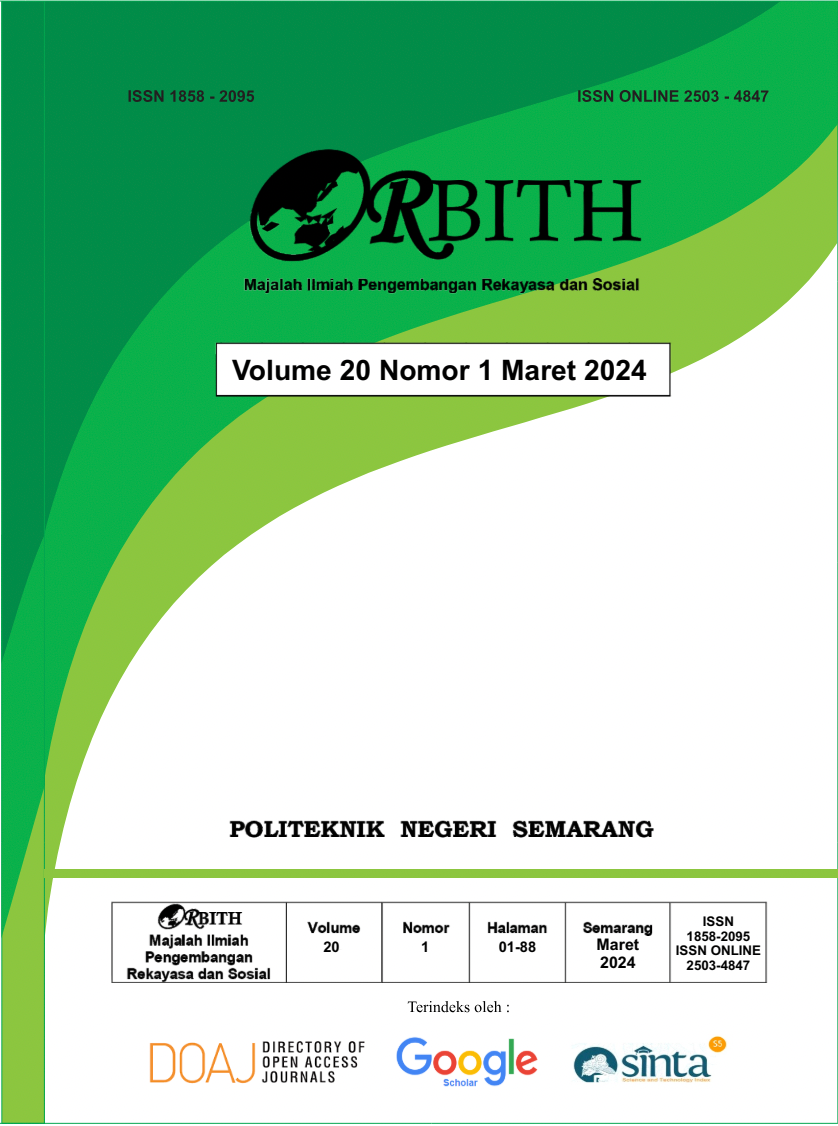PENGARUH IMPEDANSI LISTRIK SISTEM PENTANAHAN BATANG TUNGGAL YANG TERINTEGRASI DENGAN KONSTRUKSI BANGUNAN
DOI:
https://doi.org/10.32497/orbith.v20i1.5435Keywords:
impedansi, grounding, single rod, integrationAbstract
Abstrak
Sistem pentanahan yang baik akan mempunyai impedansi ≤ 5 Ω ( PUIL 2010), untuk keamanan jika ada gangguan kegagalan isolasi yang menyebabkan timbulnya tegangan sentuh. Ada beberapa faktor internal dan external yang akan mempengaruhi nilai impedansi pada sistem pentanahan. Antara lain adalah kedalaman panjang elektroda, tahanan jenis tanah , dan juga musim pada musim panas tahanan tanahnya tidak sama dengan pada saat musim penghujan, Pada penelitian ini mengambil judul “Pengaruh Impedansi listrik sistem pentanahan batang tunggal yang terintegrasi dengan konstruksi bangunan”. Yang menjadi permasalahan, seberapa besar pengaruh nilai impedansi dari sistem pentanahan batang tunggal dengan kedalaman tertentu jika diintegrasikan dengan kontruksi sebuah bangunan gedung dengan konstruksi baja. Untuk mendapatkan hasil yang baik tentu perlu dilakukan pengukuran pada beberapa tempat dimana elektroda ditanam. Hasil dari pengukuran di 6 titik lokasi elektroda pentanahan batang tunggal, sebelum dan setelah diintegrasi dengan konstriksi bangunan, menunjukkan setelah diintegrasi nilai impedansinya turun cukup signifikan.
Kata kunci: impedamsi,pentanahan,batang tunggal, integrasi
Abstract
A good grounding system will have an impedance of ≤ 5 Ω (PUIL 2010), for safety if there is an insulation failure that causes a touch voltage.There are several internal and external factors that will affect the impedance value at grounding system. Among others are the depth of the electrode length, soil resistivity, andalso the season in summer the soil resistance is not the same as during the seasonrain, in this study takes the title "Effect of electrical impedance systemsingle rod earthing integrated with building construction “. The problem is how much influence the impedance value of a single rod grounding system with a certain depth is integrated with the construction of a building with steel construction. To get good results, of course, measurements need to be made at several places where the electrodes are implanted. The results of measurements at 6 points of single rod earthing electrode locations, before and after integration with the building constriction, show that after integration the impedance value drops significantly.
Key words: impedansi, grounding, single rod, integration
References
Arrilaga, Jos and Watson, Neville. 2003 Power System Harmonics Chicester: John Walley and Sons.
Ahmed Hossam-Eldin dan Hasan M Reda. 2006. Study of The Effect of Harmonics On Measurments of The Energy Meters. Electrical Engineering Department, Alexandria University, Alexandria, Egypt.
Buhron,Hernadi and Sutanto, Justin, 2007. Implikasi Harmonisa Dalam Sistem Tenaga Listrik dan Alternatif Solusinya. PLNDistribusi Jabar.
Daniel Rohi, Dion Dwipayana Utama, Ontoseno Penangsang, 2009, Distorsi.
Joko Santoso, 2005, Pengaruh Perubahan Tegangan Catu Terhadap Umur Lampu Hemat Energi. Jurnal teknik, Undip
Luciana Kristanto, 2008, Penelitian Terhadap Kuat Penerangan dan Hubunganya Dengan Angka Reflektansi Warna Dinding , Petra. Surabaya.
Muhaimin, 2001. Teknologi Pencahayaan, Refika Aditama, Bandung
SIN 04-6958-2003 pada Lampu Hemat Energi.
Downloads
Published
Issue
Section
License
Authors who publish with this journal agree to the following terms:Authors retain copyright and grant the journal right of first publication with the work simultaneously licensed under a Creative Commons Attribution License that allows others to share the work with an acknowledgement of the work's authorship and initial publication in this journal.
Authors are able to enter into separate, additional contractual arrangements for the non-exclusive distribution of the journal's published version of the work (e.g., post it to an institutional repository or publish it in a book), with an acknowledgement of its initial publication in this journal.
Authors are permitted and encouraged to post their work online (e.g., in institutional repositories or on their website) prior to and during the submission process, as it can lead to productive exchanges, as well as earlier and greater citation of published work (See The Effect of Open Access).






